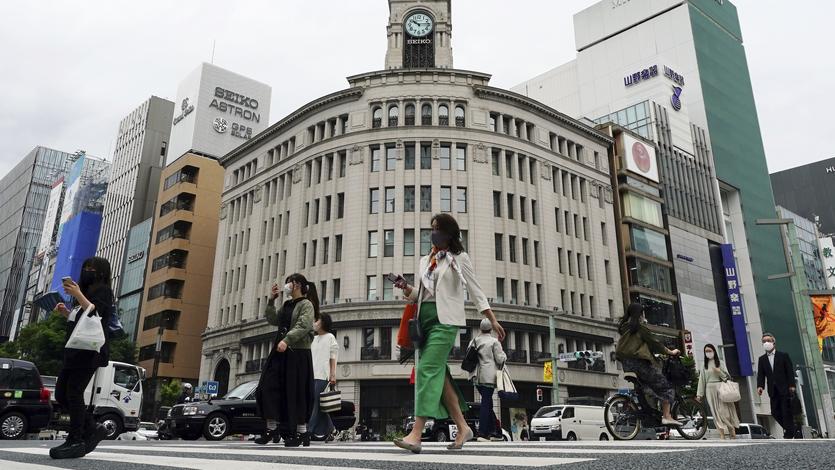 In this May 11, 2021, file photo, people wearing protective masks walk at Ginza shopping district, in Tokyo. (EUGENE HOSHIKO / AP)
In this May 11, 2021, file photo, people wearing protective masks walk at Ginza shopping district, in Tokyo. (EUGENE HOSHIKO / AP)
HONG KONG - With growth slowing, demographics depressed and the trade balance in deep deficit, Tokyo wants to incubate startups and put more state money into cutting-edge sectors like semiconductors and next-generation telecommunications. Prime Minister Fumio Kishida says he will put innovation and scientific research at the “centre” of his policy push. Perhaps it shouldn’t be.
We believe that instead of interfering in monetary policy, the government should focus on ways to spur innovation that create wealth.
Daishiro Yamagiwa, then-economy minister in Japan
There’s no question that flagging innovation is a problem in Japan. In solving it, the government hopes to find an alternative to the ultra-low interest rates Kishida’s predecessor Shinzo Abe rolled out to push growth, a strategy that is losing traction as global inflation rises.
"We believe that instead of interfering in monetary policy, the government should focus on ways to spur innovation that create wealth," said then-Economy Minister Daishiro Yamagiwa in January.
ALSO READ: Japan saw record low births, biggest population drop in 2021
That has meant pushing the $1.3 trillion Government Pension Investment Fund to get involved funding startups while removing policy bottlenecks. In the United States nearly a third of venture capital came from pensions whereas in Japan it is only 3 percent, according to a Nikkei report.
Meanwhile, Tokyo has rolled out incentives for local companies in strategic sectors to re-shore manufacturing operations.
The reasons for Japan's lowest labor productivity among the G7 countries, according to an IMF study, are mostly social: the cult of workaholism that leads Japanese employees to stay in the office even when they have nothing to do, for example
The initiatives are well-intended. However, the blunting of Japan is due more to its failure to deploy existing tools and best practices than invent new ones. Decades of economic stagnation have trained the private sector to avoid investing inside Japan.
Even now, after the yen has lost a brutal 30 percent against the dollar since January 2021, Tokyo-based finance executives told Reuters Breakingviews on a recent visit that the currency discount is still not attractive enough to convince local companies to put their extra cash to work at home.
ALSO READ: Japan passes digital law as virus underscores tech struggles
Reform dividend
An IMF study shows Japan’s labor productivity, at roughly $40 of GDP per hour worked in 2019, has been the lowest of the G7 countries since 1989.
The reasons are mostly social: the cult of workaholism that leads Japanese employees to stay in the office even when they have nothing to do, for example. The corporate tradition of promoting seniority over competence has led to absurdities – like the deputy cyber-security minister who admitted in 2018 to having never used a computer.
“Japanese workers are some of the best in the world,” quipped one private equity executive to Breakingviews, “Their bosses are useless.” Mediocre middle managers have resisted upgrading clunky legacy software and stuck with obsolete hardware like floppy disks, fax machines and ink stamps for contracts.
 A man rides a bicycle before Keihin industrial zone in Kawasaki, Japan on April 23, 2021. (PHILIP FONG / AFP)
A man rides a bicycle before Keihin industrial zone in Kawasaki, Japan on April 23, 2021. (PHILIP FONG / AFP)
The world’s third largest economy does have an innovation problem, but it is not a crisis. It enjoys a standard of living envied by its neighbors; stagnation has persisted in part because complacency is so comfortable
Technical glitches, including the failure of the backup system, caused the stock exchange to close for an entire day in 2020. Mizuho Financial Group’s software and hardware logged 11 system failures in the twelve months ending in February 2021, freezing ATMs and stalling massive transactions even after the lender plowed $2.6 billion into upgrades.
ALSO READ: Japan urges support for Renesas as global chip woes deepen
Closing the gap with American labour productivity, at roughly $70 of GDP per hour worked per the IMF paper, could nearly double the Japanese economy in size in theory.
Alternatively, employees could cut pointless office hours in half and spend more time shopping and procreating. Either outcome would be a lot more impressive than the 0.3 percent Nomura analysts predicted cryptocurrency adoption could add to Japanese GDP.
Rhetorically, Tokyo aspires to spur innovation and bin obsolete practices simultaneously. Yet politicians naturally prefer distributing tax largesse among capitalists to prying floppy disks out of bureaucrats’ cold, dead hands
The world’s third largest economy does have an innovation problem, but it is not a crisis. It enjoys a standard of living envied by its neighbors; stagnation has persisted in part because complacency is so comfortable.
And many domestic products are still superlative. Nidec claims 80 percent of the world market for the brushless motors inside hard-disk drives; little-known firms like $43 billion Shin-Etsu Chemical have a stranglehold over profitable niches in silicon wafers and key chipmaking chemicals. Manufacturing process designer Keyence is one of the world’s most profitable industrial consultancies.
READ MORE: Japanese govt and 8 leading firms launch new chip company
Rhetorically, Tokyo aspires to spur innovation and bin obsolete practices simultaneously. Yet politicians naturally prefer distributing tax largesse among capitalists to prying floppy disks out of bureaucrats’ cold, dead hands.
This may explain why the country, which in some ways resembles a robot-powered wonderland, still uses obsolete technology like fax machines. Investing in the future makes for riveting speeches, but Japan Inc will get more from reinventing itself than inventing new things.


